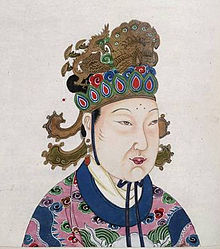Second Zhou Dynasty
| Wu Zetian |
|||||||||||||
|---|---|---|---|---|---|---|---|---|---|---|---|---|---|

Image taken from an 18th century album of portraits of 86 emperors of China, with Chinese historical notes. Originally published/produced in China, 18th century. (British Library, Shelfmark Or. 2231)
|
|||||||||||||
| Empress Regnant of the Zhou Dynasty | |||||||||||||
| Reign | 16 October 690 – 22 February 705 | ||||||||||||
| Predecessor | Dynasty established (Emperor Ruizong as Emperor of the Tang dynasty) |
||||||||||||
| Successor | Dynasty abolished (Emperor Zhongzong as Emperor of the Tang dynasty) |
||||||||||||
| Empress Dowager of the Tang Dynasty | |||||||||||||
| Tenure | 27 December 683 – 16 October 690 | ||||||||||||
| Predecessor | Empress Hu as Empress Dowager of Northern Wei | ||||||||||||
| Successor | Empress Wei | ||||||||||||
| Empress Consort of the Tang Dynasty | |||||||||||||
| Tenure | 2 December 655 – 27 December 683 | ||||||||||||
| Predecessor | Empress Wang | ||||||||||||
| Successor | Empress Wei | ||||||||||||
| Born | No record, According to the death of 83 year old speculation No record, Tang Dynasty |
||||||||||||
| Died | 16 December 705 (aged 80–81) Luoyang, Tang dynasty |
||||||||||||
| Burial | 706 Qianling Mausoleum |
||||||||||||
| Spouse | |||||||||||||
| Issue |
|
||||||||||||
|
|||||||||||||
| House | Wǔ (武) | ||||||||||||
| Dynasty |
|
||||||||||||
| Father | Wu Shihuo, Duke Ding of Ying | ||||||||||||
| Mother | Lady Yang | ||||||||||||
| Religion | Buddhism | ||||||||||||
| Full name | |
|---|---|
|
Family name: Wu (武) |
|
| Posthumous name | |
|
Short: Empress consort Zetian (則天皇后) Full: Empress consort Zetian Shunsheng (則天順聖皇后) |
|
| Temple name | |
| None |
| Wu Zetian | |||||||||||||
| Traditional Chinese | 武則天 | ||||||||||||
|---|---|---|---|---|---|---|---|---|---|---|---|---|---|
| Simplified Chinese | 武则天 | ||||||||||||
|
|||||||||||||
| Wu Zhao | |||||||||||||
| Chinese | 武曌 | ||||||||||||
|
|||||||||||||
| Wu Hou | |||||||||||||
| Chinese | 武后 | ||||||||||||
|
|||||||||||||
| Tian Hou | |||||||||||||
| Chinese | 天后 | ||||||||||||
|
|||||||||||||
| Transcriptions | |
|---|---|
| Standard Mandarin | |
| Hanyu Pinyin | Wǔ Zétiān |
| Wade–Giles | Wu3 Tse2-t'ien1 |
| Yue: Cantonese | |
| Yale Romanization | Móuh Jāktīn |
| Transcriptions | |
|---|---|
| Standard Mandarin | |
| Hanyu Pinyin | Wǔ Zhào |
| Wade–Giles | Wu3 Chao4 |
| Yue: Cantonese | |
| Yale Romanization | Móuh Jiu |
| Transcriptions | |
|---|---|
| Standard Mandarin | |
| Hanyu Pinyin | Wǔ Hòu |
| Wade–Giles | Wu3 Hou4 |
| Yue: Cantonese | |
| Yale Romanization | Móuh Hauh |
| Transcriptions | |
|---|---|
| Standard Mandarin | |
| Hanyu Pinyin | Tiān Hòu |
| Wade–Giles | T'ien1 Hou4 |
| Yue: Cantonese | |
| Yale Romanization | Tīn Hauh |
Family name: Wu (武)
Given name: first, no record. Later, Zhao (曌/瞾), possibly originally Zhao (照)
Wu Zetian (624 – December 16, 705), also known as Wu Zhao, Wu Hou, and during the later Tang dynasty as Tian Hou, referred to in English as Empress Consort Wu or by the deprecated term "Empress Wu", was a Chinese sovereign who ruled unofficially as empress consort and empress dowager and later, officially as empress regnant (皇帝) during the brief Zhou dynasty (周, 684-705), which interrupted the Tang dynasty (618–690 & 705–907). Wu was the only Empress regnant of China in more than four millennia.
Wu was the concubine of Emperor Taizong. After his death, she married his successor—his ninth son, Emperor Gaozong, officially becoming Gaozong's huanghou (皇后, variously translated as "empress", "wife", or "empress consort") in 655, although having considerable political power prior to this. After Gaozong's debilitating stroke in 660, Wu Zetian became administrator of the court, a position equal as emperor, until 705.
The importance to history of Wu Zetian's period of political and military leadership includes the major expansion of the Chinese empire, extending it far beyond its previous territorial limits, deep into Central Asia, and engaging in a series of wars on the Korean peninsula, first allying with Silla against Goguryeo, and then against Silla over occupation of formerly Goguryeo territory. Within China, besides the more direct consequences of her struggle to gain and maintain supreme power, Wu's leadership resulted in important effects regarding social class in Chinese society and in relation to state support for Taoism, Buddhism, education, and literature. Wu Zetian also had a monumental impact upon the statuary of the Longmen Grottoes and the "Wordless Stele" at the Qianling Mausoleum, as well as the construction of some major buildings and bronze castings that no longer survive.
...
Wikipedia
